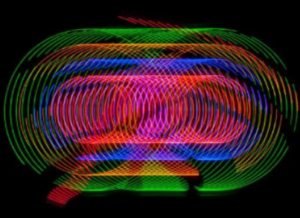Welcome to Edinburgh Instruments’ blog celebrating our work in Raman, Photoluminescence, and Fluorescence Lifetime Imaging. Every month, we aim to highlight our pick for Map of the Month to show how our Raman and fluorescence spectrometers can be used to reveal all the hidden secrets in your samples.
Gallium nitride (GaN) is a wide bandgap semiconductor that is the material responsible for the blue light-emitting diode (LED), a Nobel prize-winning discovery. As well as being used extensively in the photonics industry, it has promise as a potential replacement for silicon in components where small sizes and high energy densities are required, as well as in environments where external temperatures are higher, such as in automobile electronics.
To acquire high-quality devices containing GaN, manufacturers must carefully monitor their optoelectronic properties, which are liable to change in the presence of heterogeneity introduced by strain and crystal defects. Raman and photoluminescence (PL) are examples of non-destructive techniques capable of resolving even the most subtle changes in GaN-based materials. When these techniques are coupled to a microscope, the properties of the devices can be imaged with a high spatial resolution.
In our recent application note, we showed how the Edinburgh Instruments RMS1000 Confocal Microscope can be used to perform Raman and PL imaging on a GaN-based LED device, a picture of which is shown in panel (a) above. In this Map of the Month blog we highlight the information provided about the LED by PL imaging. PL directly measures bandgaps in semiconductors, and since bandgap energies are highly sensitive to impurities such as dopants and defects, microscopic analysis can yield detailed information about their presence. PL imaging was conducted on the region on the chip shown in panel (a) above, and false colour imaging was performed using UV and visible bands. Since GaN exhibits PL in the UV, a 325 nm He-Cd laser was required for excitation, which was externally coupled to the RMS1000.
The UV (3.40 eV or 364 nm) PL intensity image in panel (b) above shows that the N-GaN exhibits PL, and the P-GaN does not. P doping of GaN using Mg has been shown previously to dampen the UV emission. The N-GaN region emits strongly except for a region in the top right-hand side of the image. In the application note, we demonstrated that this drop in UV PL was due to compressive strain in the N-GaN crystalline structure, which we probed using peak position Raman imaging.
The visible band at 2.38 eV (520 nm) corresponds to PL from InGaN, the layer sandwiched between the P- and N-GaN that gives the LED its green colour. The image in panel (c) shows that this emission was largely confined to the black strip at the boundary of the P and N layers. The spectra in panel (d) show that the emission was more intense and blue-shifted from the weak visible emissions in the N-GaN layer.
Read our full application note, Raman and Photoluminescence of Gallium Nitride to find out how Raman microscopy was also used to analyse this GaN-based LED.

